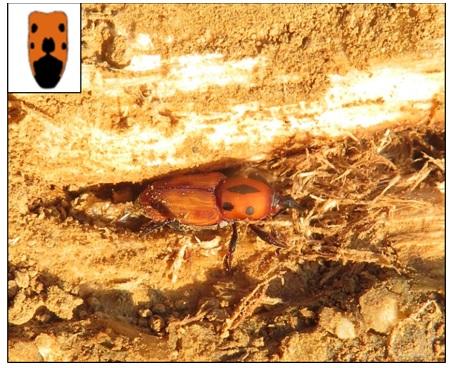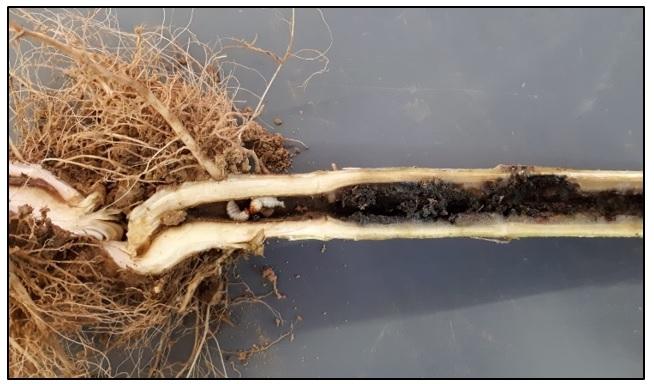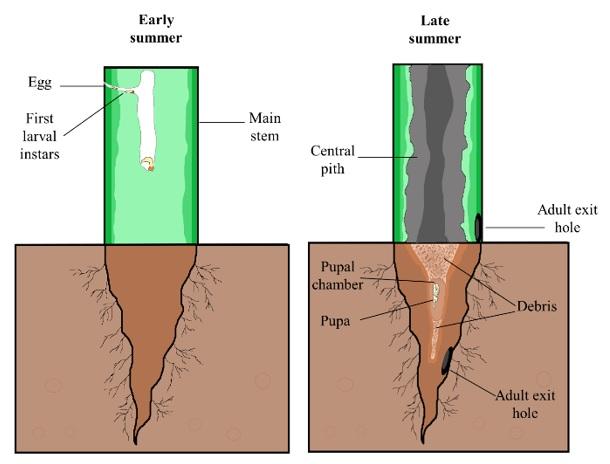ENTFACT-159: Red Cocklebur Weevil | Download PDF
Raul T. Villanueva, Extension Specialist and Armando Falcon-Brindis, Research Analyst
Background
Trap cropping is a technique where a very attractive plant grows in the perimeter, corner or around a field and attracts agricultural pests, usually insects, to intercept them from colonizing nearby crops. These trap plants prevent the pest from reaching the main crop. Insects congregated on trap crop plants can be more easily killed with insecticides to reduce the infestations on the main crop. In Kentucky, sunflower (Helianthus annuus) was evaluated as a trap crop for management of Dectes stem borer, Dectes texanus LeConte (Coleoptera Cerambycidae) in soybeans. However, sunflower was found to host red cocklebur weevil Rhodobaenus quinquepunctatus Say (Coleoptera: Curculionidae) along with Dectes stem borer.
Figure 1. Distribution of the red cocklebur weevil. Figure by A. Falcon-Brindis. Occurrences obtained from GBIF (2022).
Description and Taxonomy
The red cocklebur weevil belongs to one of the most diverse families of beetles of North America (~ 3,000 species). This species is commonly found in southeastern Canada and central-eastern United States. There are a few records from Central Mexico and Central America though (Fig. 1).
The red cocklebur weevil is an elongated beetle (5 to 7.5 mm body length, see Fig. 2) separated from other species of the same genus by having the rostrum with basal dilation not or rarely sulcate; third tarsal segment widely dilated, and pronotum with median black mark generally elongate and distinctly larger than other spots (Fig. 3). The red color and black spots on the upper surface of the thorax and abdomen often confuse R.quinquepunctatus and the ironweed curculio, R.tredecimpunctatus, but in the latter species, basal dilation of the snout has groves (sulcate) and the median back spot in the thorax is not quite elongate. The number and size of black dots on the elytra can be variable in R.quinquepunctatus, from darker forms to individuals with few or no dots (see Fig. 3).
Host Plants and Damage
The three species of Rhodobaenus occurring in the United States (R. quinquepunctatus, R. pustulosus, and R. tredecimpunctatus) are not economically important but often seen in field crops. They do not generally attack useful plants in agriculture. Red cocklebur weevil seems to feed primarily on Asteraceae species. including sunflowers, ragweed, thistle, cocklebur, joe-pye weed, ironweed, and rosinweed. In western Kentucky, larvae can infest up to 95% of certain cultivated sunflower varieties. When infested, the host plant is apparently healthy from the outside as red cocklebur weevil feeds exclusively on the pith (see Figs. 4-5).
Figure 3. Adult red cocklebur weevil emerging from sunflower. Common elytral (hardened forewings pattern is displayed in the upper left (modified from Vaurie, 1981). Notice the large diamond shape black spot in the mid area of thorax. Photo by A. Falcon-Brindis.
Biology and Ecology
The life history of red cocklebur weevil remains unknown, but it has been suggested that the biology may be similar to the ironweed curculio as both species are found in central and eastern states in the USA. After the overwintering period, adults emerge in early to mid-summer, depending on the location. In Kentucky, adults were observed since mid-May in sunflower. Adults feed on stems and petioles, with feeding sites usually turn black and become distorted. In ironweed, most eggs are deposited in the upper portion of young stems. The egg cavity is shallow and longer than wide. After hatching, the larva bores up into the center of the stem for a short distance, and then, it bores down as it feeds on stem and root tissues. Infested stems usually contain small openings full of debris, which is quite likely that the larva makes them to get rid of frass. There is usually one larva per host but in western Kentucky, we have found sunflower plants with two to three larvae (Fig. 4) and many exit holes that may indicate higher larval presence. Fully developed larvae can be found in early-August. Larvae are subcylindrical, ~ 11 mm long, creamy white, head reddish brown. The pupal chamber is located at the bottom of the main stem and can be recognized by packed debris surrounding the chamber. During late August or early September, adults chew their way out of the plant (Fig. 5). Some adults can still be found within the stem in mid-October.
Figure 4. Larvae of red cocklebur weevil found in sunflower. Notice the damaged tissue along the pith. Photo by A. Falcon-Brindis.
Further Readings
- Anderson, R. S. 2002. Chapter 131. Curculionidae [pp. 722–815]. In: American Beetles Polyphaga: Scarabaeioidea through Curculionoidea, Volume 2 (R. H. Arnett, Jr., M. C. Thomas, P. E. Skelley, and J. H. Frank, editors). CRC Press, Boca Raton, FL. 861 pp.
- Michaud, J. P., Jawwad A. Qureshi, and Angela K. Grant. Sunflowers as a trap crop for reducing soybean losses to the stalk borer Dectes texanus (Coleoptera: Cerambycidae). Pest Management Science: formerly Pesticide Science 63.9 (2007): 903-909.
- Vaurie, P. 1980. Revision of Rhodobaenus. Part 1, Species in South America (Coleoptera, Curculionidae, Rhynchophorinae). Bulletin of the AMNH (167: 1)
- Vaurie, P. 1981. Revision of Rhodobaenus. Part 2, Species in North America (Canada to Panama) (Coleoptera, Curculionidae, Rhynchophorinae). Bulletin of the AMNH (171:2)
- Weiss, H. B., and R. B. Lott 1923. Notes on Rhodobaenus 13-punctatus (III.), the Cockle-Bur Bill-Bug (Col.). Ent. News, vol. 34, pp. 103-106.
Figure 5. Diagram of the infestation of sunflower by the red cocklebur weevil. Longitudinal section of the host plant: after egg hatch, the larva moves to feed in the pith, which eventually turns necrotic and is no longer occupied by the larva. The pupal chamber is surrounded by debris. Finally, the adult escapes through holes bored either in the root or stem. Graph designed by A. Falcon-Brindis.
Issued: 5/22
CAUTION! Pesticide recommendations in this publication are registered for use in Kentucky, USA ONLY! The use of some products may not be legal in your state or country. Please check with your local county agent or regulatory official before using any pesticide mentioned in this publication.
Of course, ALWAYS READ AND FOLLOW LABEL DIRECTIONS FOR SAFE USE OF ANY PESTICIDE!



















